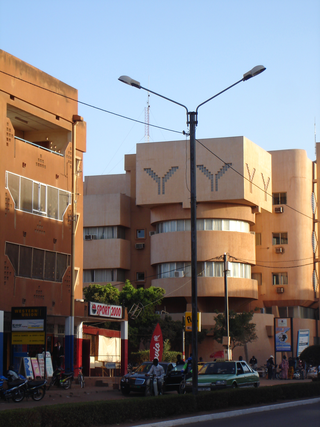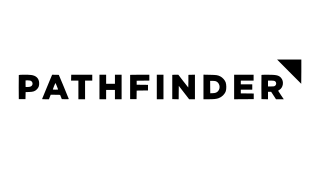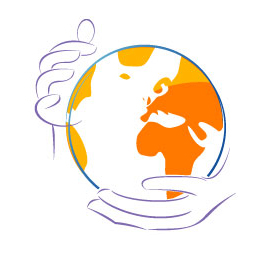Related Research Articles

Burkina Faso is a landlocked country in West Africa. It covers an area of 274,223 km2 (105,878 sq mi), bordered by Mali to the northwest, Niger to the northeast, Benin to the southeast, Togo and Ghana to the south, and Ivory Coast to the southwest. As of 2021, the country had an estimated population of 20,321,378. Previously called Republic of Upper Volta (1958–1984), it was renamed Burkina Faso by President Thomas Sankara. Its citizens are known as Burkinabè, and its capital and largest city is Ouagadougou.

The economy of Burkina Faso is based primarily on subsistence farming and livestock raising. Burkina Faso has an average income purchasing-power-parity per capita of $1,900 and nominal per capita of $790 in 2014. More than 80% of the population relies on subsistence agriculture, with only a small fraction directly involved in industry and services. Highly variable rainfall, poor soils, lack of adequate communications and other infrastructure, a low literacy rate, and a stagnant economy are all longstanding problems of this landlocked country. The export economy also remained subject to fluctuations in world prices.

In the United Nations, the Millennium Development Goals (MDGs) were eight international development goals for the year 2015 created following the Millennium Summit, following the adoption of the United Nations Millennium Declaration. These were based on the OECD DAC International Development Goals agreed by Development Ministers in the "Shaping the 21st Century Strategy". The Sustainable Development Goals (SDGs) succeeded the MDGs in 2016.

Alassane Dramane Ouattara is an Ivorian politician who has been President of Ivory Coast since 2010. An economist by profession, he worked for the International Monetary Fund (IMF) and the Central Bank of West African States, and was the Prime Minister of Côte d'Ivoire from November 1990 to December 1993, appointed to that post by then-President Félix Houphouët-Boigny. Ouattara became the President of the Rally of the Republicans (RDR), an Ivorian political party, in 1999.
An International Finance Facility (IFF) is a bond issued against the security of donor government guarantees to maintain future aid flows for the purpose of international development.

Pathfinder International is a global non-profit organization that focuses on sexual and reproductive health and rights, including reproductive health, family planning, HIV/AIDS prevention and care, and maternal and newborn health. The organization operates in more than 15 low- and middle-income countries in Africa and South Asia. According to its website, "Pathfinder is driven by the conviction that all people, regardless of where they live, have the right to decide whether and when to have children, to exist free from fear and stigma, and to lead the lives they choose."

The Federation of Green Parties of Africa is an umbrella body of the various national Green parties and environmental parties in Africa. The formal coalition, the African Greens Federation (AGF) formed in 2010 at a conference in Kampala, Uganda. As part of the Global Greens, founded in 2001 in Canberra, Australia, the parties included in the Federation of Green Parties of Africa follow the Global Greens Charter. The organization's permanent administration is in Ouagadougou, the capital of Burkina Faso, where the predominant green organization is the Rassemblement Des Ecologistes du Burkina Faso. These parties tend to, but not always, be left-leaning and often do not have widespread support in their respective countries.

Child labour is a recurring issue in cocoa production. Cote d’Ivoire and Ghana, together produce nearly 60% of the world's cocoa each year. During the 2018/19 cocoa-growing season, research commissioned by the U.S. Department of Labor was conducted by NORC at the University of Chicago in these two countries and found that 1.48 million children are engaged in hazardous work on cocoa farms including working with sharp tools and agricultural chemicals and carrying heavy loads. That number of children is significant, representing 43 percent of all children living in agricultural households in cocoa growing areas. During the same period cocoa production in Cote d’Ivoire and Ghana increased 62 percent while the prevalence of child labour in cocoa production among all agricultural households increased 14 percentage points. Attention on this subject has focused on West Africa, which collectively supplies 69% of the world's cocoa, and Côte d'Ivoire, supplying 35%, in particular. The 2016 Global Estimates of Child Labour indicate that one-fifth of all African children are involved in child labour. Nine percent of African children are in hazardous work. It is estimated that more than 1.8 million children in West Africa are involved in growing cocoa. A 2013–14 survey commissioned by the Department of Labor and conducted by Tulane University found that an estimated 1.4 million children aged 5 years old to 11 years old worked in agriculture in cocoa-growing areas, while approximately 800,000 of them were engaged in hazardous work, including working with sharp tools and agricultural chemicals and carrying heavy loads. According to the NORC study, methodological differences between the 2018/9 survey and earlier ones, together with errors in the administration of the 2013/4 survey have made it challenging to document changes in the number of children engaged in child labour over the past five years.

The African Development Bank Group (AfDB) or Banque Africaine de Développement (BAD) is a multilateral development finance institution headquartered in Abidjan, Ivory Coast, since September 2014. The AfDB is a financial provider to African governments and private companies investing in the regional member countries (RMC).

The economy of Ivory Coast is stable and currently growing, in the aftermath of political instability in recent decades. The Ivory Coast's economy is largely market-based and depends heavily on the agricultural sector. Almost 70% of the Ivorian people are engaged in some form of agricultural activity. GDP per capitaArchived 4 May 2012 at the Wayback Machine grew 82% in the 1960s, reaching a peak growth of 360% in the 1970s, but this proved unsustainable and it shrank by 28% in the 1980s and a further 22% in the 1990s. This decline, coupled with high population growth, resulted in a steady fall in living standards. The Gross national product per capita, now rising again, was about US$727 in 1996. It was substantially higher two decades before.
Inga Björk-Klevby, is the former United Nations Deputy Executive Director of the United Nations Human Settlements Programme (UN-HABITAT). She was appointed to this position by United Nations Secretary-General Kofi Annan in October 2005.

The Leading Group on Innovative Financing for Development is a global platform made up of 55 member countries with differing levels of development, operating alongside international organisations and NGOs. Formerly known as the Leading Group on Solidarity Levies to Fund Development, the Leading Group seeks to promote the implementation and definition of innovative financing mechanisms around the world.

A landlocked sub-Saharan country, Burkina Faso is among the poorest countries in the world—44 percent of its population lives below the international poverty line of US$1.90 per day —and it ranks 185th out of 188 countries on UNDP's 2016 Human Development Index .Rapid population growth, gender inequality, and low levels of educational attainment contribute to food insecurity and poverty in Burkina Faso. The total population is just over 20 million with the estimated population growth rate is 3.1 percent per year and seven out of 10 Burkinabe are younger than 30. Total health care expenditures were an estimated 5% of GDP. Total expenditure on health per capita is 82 in 2014.
Prostitution in Burkina Faso is not specifically prohibited by the law, but soliciting and pimping are illegal. Burkinabe society only accepts sexual intercourse within marriage. In 2009, Voice of America reported that the number of prostitutes in Burkina Faso had increased as a result of the country's poverty. The increase in prostitution has given rise to fears of an increase in the number of Burkinabés infected with HIV and AIDS. UNAIDS estimate there to be 31,000 prostitutes in the country.
The Global Strategy for Women's and Children's Health was a program of the United Nations (UN) directed at improving women's and children's health in the developing world.

Although access to water supply and sanitation in sub-Saharan Africa has been steadily improving over the last two decades, the region still lags behind all other developing regions. Access to improved water supply had increased from 49% in 1990 to 68% in 2015, while access to improved sanitation had only risen from 28% to 31% in that same period. Sub-Saharan Africa did not meet the Millennium Development Goals of halving the share of the population without access to safe drinking water and sanitation between 1990 and 2015. There still exists large disparities among sub-Saharan African countries, and between the urban and rural areas.
Science and technology in Burkina Faso summarises the changes and trends that have occurred in this area in Burkina Faso from 2010 and places them in the viewpoint of the subregion.
The Saudi Fund for Development (SFD) is a Saudi Arabian government agency that provides development assistance to developing countries by financing social and infrastructure projects. The fund seeks to support the economies of recipient countries by enhancing economic growth and promoting job opportunities. SFD was established in 1974 and began operations in 1975. Through actions including development, finance, trade, and funding, the SFD has continued to expand. Today, it is involved in 3750 projects in 71 countries. The fund is led by H.E. Mr. Ahmed bin Aqeel Al-Khateeb who also serves as the Minister of Tourism for Saudi Arabia.

The Republic of Zimbabwe is a landlocked country locked in the southern region of Africa. It shares borders with The Republic of South Africa, Botswana, Zambia, and Mozambique. Upon gaining independence in 1980, the new regime, sought to replace many of the institutions established by the previous white rule. Many of the new regime's actions, like land reform and involvement in The Democratic Republic of the Congo's civil war, have been the source of the state's economic failure.
References
- ↑ "Playing catchup: funding for education still lags behind health". Financial Times. 10 October 2018. Retrieved 31 October 2018.
- ↑ "About Us". Global Financing Facility. Retrieved 31 October 2018.
- ↑ "Global Financing Facility Launched with Billions Already Mobilized to End Maternal and Child Mortality by 2030". World Bank. 13 July 2015. Retrieved 6 February 2019.
- ↑ "A look at the Global Financing Facility's goals, strategies, and learnings". Devex. 24 July 2018. Retrieved 31 October 2018.
- ↑ "The Global Financing Facility - An Opportunity to Get it Right". Reliefweb. 19 April 2018. Retrieved 31 October 2018.
- ↑ "Donors pledge $1 billion for maternal and child health fund". Reuters. 6 November 2018. Retrieved 6 February 2019.
- ↑ "Global Health Organizations Commit to New Ways of Working Together for Greater Impact". United News of India. 16 October 2018. Retrieved 31 October 2018.
- ↑ "World Bank Injects $115 Million to Boost Covid-19 Vaccination in Mozambique". World Bank. Retrieved 2021-06-07.
- ↑ "Call for more funding to save lives of 35m women and children in world's poorest countries". Telegraph. 3 October 2018. Retrieved 31 October 2018.